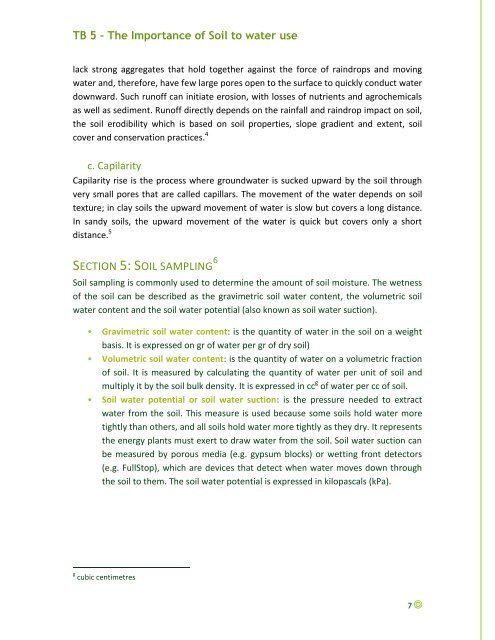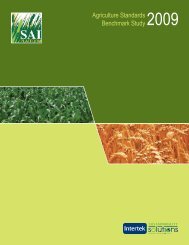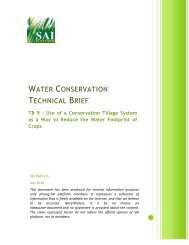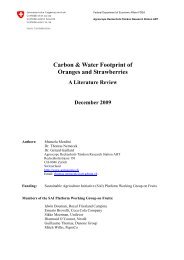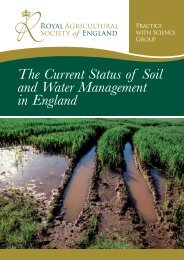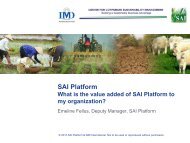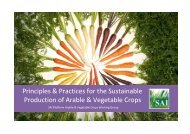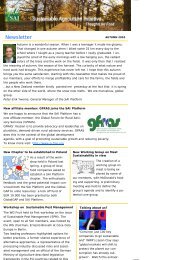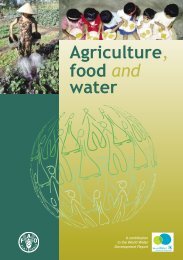The Importance of Soil to Water Use - SAI Platform
The Importance of Soil to Water Use - SAI Platform
The Importance of Soil to Water Use - SAI Platform
You also want an ePaper? Increase the reach of your titles
YUMPU automatically turns print PDFs into web optimized ePapers that Google loves.
TB 5 – <strong>The</strong> <strong>Importance</strong> <strong>of</strong> <strong>Soil</strong> <strong>to</strong> water use<br />
lack strong aggregates that hold <strong>to</strong>gether against the force <strong>of</strong> raindrops and moving<br />
water and, therefore, have few large pores open <strong>to</strong> the surface <strong>to</strong> quickly conduct water<br />
downward. Such run<strong>of</strong>f can initiate erosion, with losses <strong>of</strong> nutrients and agrochemicals<br />
as well as sediment. Run<strong>of</strong>f directly depends on the rainfall and raindrop impact on soil,<br />
the soil erodibility which is based on soil properties, slope gradient and extent, soil<br />
cover and conservation practices. 4<br />
c. Capilarity<br />
Capilarity rise is the process where groundwater is sucked upward by the soil through<br />
very small pores that are called capillars. <strong>The</strong> movement <strong>of</strong> the water depends on soil<br />
texture; in clay soils the upward movement <strong>of</strong> water is slow but covers a long distance.<br />
In sandy soils, the upward movement <strong>of</strong> the water is quick but covers only a short<br />
distance. 5<br />
SECTION 5: SOIL SAMPLING 6<br />
<strong>Soil</strong> sampling is commonly used <strong>to</strong> determine the amount <strong>of</strong> soil moisture. <strong>The</strong> wetness<br />
<strong>of</strong> the soil can be described as the gravimetric soil water content, the volumetric soil<br />
water content and the soil water potential (also known as soil water suction).<br />
• Gravimetric soil water content: is the quantity <strong>of</strong> water in the soil on a weight<br />
basis. It is expressed on gr <strong>of</strong> water per gr <strong>of</strong> dry soil)<br />
• Volumetric soil water content: is the quantity <strong>of</strong> water on a volumetric fraction<br />
<strong>of</strong> soil. It is measured by calculating the quantity <strong>of</strong> water per unit <strong>of</strong> soil and<br />
multiply it by the soil bulk density. It is expressed in cc g <strong>of</strong> water per cc <strong>of</strong> soil.<br />
• <strong>Soil</strong> water potential or soil water suction: is the pressure needed <strong>to</strong> extract<br />
water from the soil. This measure is used because some soils hold water more<br />
tightly than others, and all soils hold water more tightly as they dry. It represents<br />
the energy plants must exert <strong>to</strong> draw water from the soil. <strong>Soil</strong> water suction can<br />
be measured by porous media (e.g. gypsum blocks) or wetting front detec<strong>to</strong>rs<br />
(e.g. FullS<strong>to</strong>p), which are devices that detect when water moves down through<br />
the soil <strong>to</strong> them. <strong>The</strong> soil water potential is expressed in kilopascals (kPa).<br />
g cubic centimetres<br />
7


